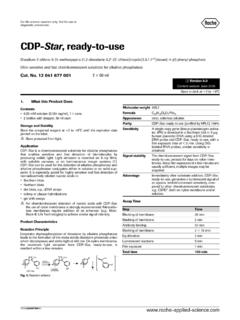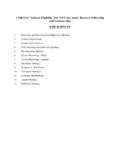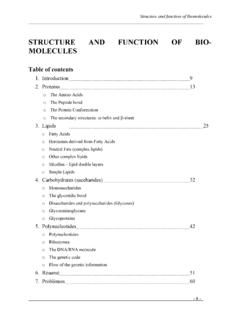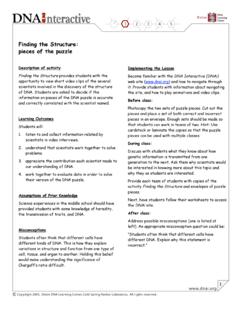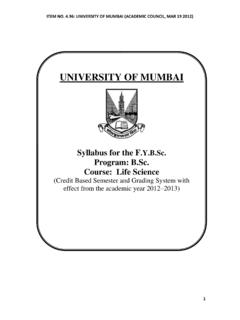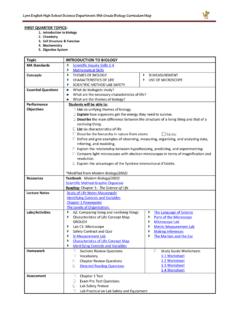Transcription of Proteinase K, recombinant, PCR Grade - Roche
1 Lot-specific data Proteinase K, recombinant , PCR Grade Solution 03 115 828 001/ 5 ml / ( mg/ml). Lot. No. 14300900/ 30 Sep 2009. Volume activity (hemoglobin): 878 U/ml Specific activity (hemoglobin); U/mg For general laboratory use. Not for use in diagnostic procedures. FOR IN VITRO USE ONLY. Proteinase K, recombinant , PCR Grade From Pichia pastoris in solution Cat. No. 03 115 887 001 ml Version Nov. 2005. Cat. No. 03 115 828 001 5 ml Store at +2 to +8 C. Cat. No. 03 115 844 001 25 ml 1. What this Product Does Isolation of genomic DNA from mammalian tissue (5): The start- ing material can be 80 mg minced mammalian tissue, 80 mg of tissue Contents and Concentration that has been frozen in liquid nitrogen, or 1 108 cultured mammalian Solution cells (5).
2 Incubate the starting material for 12 18 h at +50 C in 1 ml digestion buffer that contains 100 g/ml Proteinase K and SDS. The concentration of the enzyme solution is 14 22 mg/ml in 10 mM (w/v). Tris-HCl, pH The solution contains calcium acetate as stabilizer. Preparation of tissue sections for in situ hybridization: For some Storage and Stability tissues, treatment of cytological sections with Proteinase K will The undiluted enzyme is stable at +2 to +8 C through the expiration improve the likelihood that probes will reach cellular nucleic acids. The date printed on the label. effectiveness of Proteinase K treatment and the optimal concentration of Proteinase K depend greatly on the kind of tissue and how it was Applications fixed.
3 For example, to treat blood vessel or myocardial tissue, Plenz et Proteinase K, recombinant , PCR Grade , digests native proteins very al (7) used the following concentrations of Proteinase K: effectively. It can therefore be used to rapidly inactivate endogenous Cryosections: up to 2 g/ml RNases and DNases (1, 2) during nucleic acid isolation (4, 5). This Paraffin-embedded sections: up to 20 g/ml property makes Proteinase K particularly suitable for the isolation of Methacrylate-embedded sections: up to 50 g/ml native RNA and DNA from tissues or cell lines. The enzyme also pro- motes cell lysis by activating a bacterial autolytic factor. Proteinase K is also used for the analysis of membrane structures by modifying pro- 3.
4 Additional Information on this Product teins and glycoproteins on cell surfaces. Because the solution is tested Background Information for the absence of RNases and DNases, and is virtually free of DNA, it is especially suitable for isolating PCR and RT-PCR templates. Protein- Proteinase K is a subtilisin-related serine protease. The recombinant ase K can also be used to remove cellular debris during the prepara- enzyme is identical to the native protease originally isolated from the tion of colony lifts (15), and to treat tissue sections to ensure efficient mold, Tritirachium album. The specifications of the recombinant probe infiltration during in situ hybridization (6). enzyme are the same as those of the native protease.
5 The amino acid sequence (molecular weight) and the molecule structure (enthalpy for 2. How to Use this Product denaturation) are identical. However, the recombinant preparation is much purer than the native Suggested Buffers enzyme. In particular, since Proteinase K, recombinant , PCR Grade , is The best buffer for Proteinase K will vary from application to applica- DNA-free, it is especially suitable for isolating PCR and RT-PCR tem- tion. Always follow the pH and temperature guidelines above. As a plates. general rule, Proteinase K is stable and very active in buffers that con- Enzyme Characteristics tain denaturing reagents such as urea, sodium dodecyl sulfate (SDS), and guanidinium salts. Volume 50 U/ml.
6 One unit is the enzyme activity which Activity cleaves at +25 C in 1 min 18 mmol Chromozym TRY. Typical Experiments (equivalent to 600 U/ml with the hemoglobin assay). Isolation of nucleic acids: Use Proteinase K, recombinant , PCR Specific Activity Approx. U /mg, when assayed with the Chro- Grade , with the High Pure PCR Template Preparation Kit* to isolate mozym assay (equivalent to 30 U/mg with the nucleic acids from: hemoglobin assay). 200 l mammalian blood Cleavage Proteinase K is one of the most active endo- 200 l buffy coat Specificity peptidases known and does not show any pro- 104 105 cultured mammalian cells nounced cleavage specificity. Proteinase K cleaves 25 50 mg mammalian tissue proteins as follows: cm (25 50 mg) mouse tail X- -Y-, where X = aliphatic, aromatic or hydropho- 109 bacteria or 108 yeast cells bic amino acid and Y = any amino acid.
7 25 50 mg formalin-fixed paraffin-embedded tissue section L If excess Proteinase K is incubated with proteins Add 40 l of the Proteinase K solution to each sample. Then follow the for a long time, the enzyme will degrade the procedure described in the pack insert of the High Pure PCR Template proteins to free amino acids. Preparation Kit, which is available online at Isolation of cytoplasmic RNA from cultured cells (5): Lyse cells in a buffer containing (v/v) Nonidet P-40* (non-ionic detergent). Centrifuge the lysate, then transfer the supernatant to a clean tube containing 4 l of 20% SDS. Immediately vortex the tube to mix the contents. Add l of 20 mg/ml Proteinase K to the tube and incu- bate for 15 min at +37 C.
8 Roche Applied Science pH and recombinant Proteinase K is stable from pH to 4. Supplementary Information Temperature pH It retains full activity for several hours when incubated at pH Conventions The enzyme is 12 times more active at +65 C than at +25 C. However, it is rapidly denatured at tem- Text Conventions peratures above +65 C. To make information consistent and memorable, the following text conventions are used in L For more information, see the article on pp. 16 this package insert: 17 of Biochemica 2003 (3). This article is avail- Text Convention Use able online at: Asterisk * Denotes a product available from Roche Applied Sci- ence BIOCHEMI/no3_03/ Symbols Activators To stimulate Proteinase K activity, add denaturing In this package insert the following symbols are used to highlight important information: agents (SDS and urea).
9 For example, SDS can increase the activity of Proteinase K as much as Symbol Description sevenfold (3). L Information Note: Additional information about the current topic or procedure. Inhibitors Proteinase K is inhibited by diisopropyl fluorophos- phate and phenylmethylsulfonyl fluoride (PMSF). It Ordering Information is also totally inactivated by mercury ions. Pefabloc Roche Applied Science offers a large selection of reagents and systems for life science SC* and Pefabloc PLUS* are specific, irreversible, research. For a complete overview of related products and manuals, please visit and book- non-toxic inhibitors of Proteinase K. mark our home page, , and our Special Interest N Proteinase K is not inactivated by metal ions, Sites including: The MagNA Pure family for automated nucleic acid isolation: chelating agents ( , EDTA), sulfhydryl reagents or trypsin/chymotrypsin inhibitors.
10 Manual Nucleic Acid Isolation and Purification: Autolysis Autolysis of the enzyme occurs more rapidly at alka- The LightCycler System Family for real-time, online PCR: line pH. However, Proteinase K is not completely inactivated by autolysis. Some enzyme fragments PCR - Innovative Tools for Amplification: retain complete proteolytic activity. Product Pack Size Cat. No. Quality Control Proteinase K, 25 mg 03 115 836 001. Absence of lEco RI/Hind III fragments ( g) are incubated recombinant , 100 mg 03 115 879 001. Endonucleases with Proteinase K for 16 h at +37 C in 36 l 10 mM PCR Grade 2 250 mg 03 115 801 001. (lyophilizate) 4 250 mg 03 115 852 001. Tris-HCl, pH The DNA shows no degradation after incubation with up to 200 g Proteinase K.
